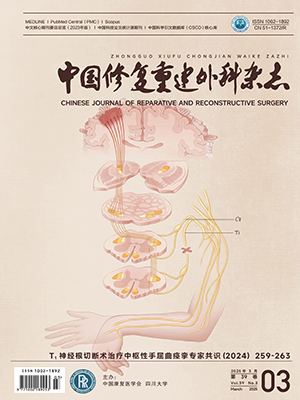| 1. |
Dimitriou R, Mataliotakis GI, Angoules AG, et al. Complications following autologous bone graft harvesting from the iliac crest and using the RIA: a systematic review. Injury, 2011, 42 Suppl 2: S3-S15.
|
| 2. |
张仁坤, 涂悦, 赵明亮, 等. 3-D打印胶原蛋白-硫酸肝素仿生脊髓支架的研究.中国修复重建外科杂志, 2015, 29(8): 1028-1033.
|
| 3. |
魏学磊, 董福慧.计算机辅助成型技术制备骨组织工程支架的研究进展.中国修复重建外科杂志, 2011, 25(12): 1508-1512.
|
| 4. |
Liu FH. Fabrication of bioceramic bone scaffolds for tissue engineering. Journal of Materials Engineering and Performance, 2014, 23 (10): 3762-3769.
|
| 5. |
孙凯, 年争好, 徐成, 等.丝素蛋白复合胶原蛋白支架的制备及性能研究.中国修复重建外科杂志, 2014, 28(7): 903-908.
|
| 6. |
Liu Y, Lim J, Teoh SH. Review: development of clinically relevant scaffolds for vascularised bone tissue engineering. Biotechnol Adv, 2013, 31(5): 688-705.
|
| 7. |
Wei G, Li C, Fu Q, et al. Preparation of PCL/silk fibroin/collagen electrospun fiber for urethral reconstruction. Int Urol Nephrol, 2015, 47 (1): 95-99.
|
| 8. |
陆史俊, 左保齐, 刘洪臣.丝素蛋白生物支架材料在骨组织工程中的应用进展.中国修复重建外科杂志, 2014, 28(10): 1307-1310.
|
| 9. |
蓝旭, 许建中, 刘雪梅, 等.丝素蛋白/羟基磷灰石复合材料细胞相容性的研究.实用骨科杂志, 2013, 19(3): 226-229.
|
| 10. |
Li ZY, Mi WY, Wang HL, et al. Nano-hydroxyapatite/polyacrylamide composite hydrogels with high mechanical strengths and cell adhesion properties. Colloids and Surfaces B: Biointerfaces, 2014, 123: 959-964.
|
| 11. |
徐水, 张胡静, 张海萍, 等.高强度力学性能丝素/羟基磷灰石多孔支架材料的初步制备.高分子材料科学与工程, 2011, 27(10): 150-153.
|
| 12. |
Meinel L, Fajardo R, Hofmann S, et al. Silk implants for the healing of critical size bone defects. Bone, 2005, 37(5): 688-698.
|
| 13. |
Vachiraroj N, Ratanavaraporn J, Damrongsakkul S, et al. A comparison of Thai silk fibroin-based and chitosan-based materials on in vitro biocompatibility for bone substitutes. Int J Biol Macromol, 2009, 45(5): 470-477.
|
| 14. |
Wu SL, Liu XM, Yeung KWK, et al. Biomimetic porous scaffolds for bone tissue engineering. Materials Science and Engineering R, 2014, 80: 1-36.
|
| 15. |
Sun F, Zhou H, Lee J. Various preparation methods of highly porous hydroxyapatite/polymer nanoscale biocomposites for bone regeneration. Acta Biomater, 2011, 7(11): 3813-3828.
|
| 16. |
Zhao C, Tan A, Pastorin G, et al. Nanomaterial scaffolds for stem cell proliferation and differentiation in tissue engineering. Biotechnol Adv, 2013, 31(5): 654-668.
|
| 17. |
Arahira T, Maruta M, Matsuya S, et al. Development and characterization of a novel porousβ-TCP scaffold with a three-dimensional PLLA network structure for use in bone tissue engineering. Materials Letters, 2015, (152): 148-150.
|
| 18. |
Domingos M, Intranuovo F, Gloria A, et al. Improved osteoblast cell affinity on plasma-modified 3-D extruded PCL scaffolds. Acta Biomaterialia, 2013, 9(4): 5997-6005.
|
| 19. |
Yoon YJ, Moon SK, Hwang JH. 3D printing as an efficient way for comparative study of biomimetic structures-trabecular bone and honeycomb. Journal of Mechanical Science and Technology, 2014, 28(11): 4635-4640.
|
| 20. |
Korpela J, Kokkari A, Korhonen H, et al. Biodegradable and bioactive porous scaffold structures prepared using fused deposition modeling. J Biomed Mater Res B Appl Biomater, 2012, 101(4): 610-619.
|
| 21. |
Bhumiratana S, Grayson W, Castaneda A, et al. Nucleation and growth of mineralized bone matrix on silk-hydroxyapatite composite scaffolds. Biomaterials, 2011, 32 (11): 2812-2820.
|
| 22. |
年争好, 李晖, 李瑞欣, 等.纳米羟基磷灰石/胶原蛋白/丝素蛋白复合骨组织工程支架材料的生物相容性.中国组织工程研究, 2015, 19(8): 1149-1154.
|




